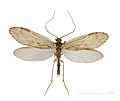| Eumetabola | |
|---|---|
 | |
| Apis dorsata on Tribulus terrestris | |
| Scientific classification | |
| Kingdom: | Animalia |
| Phylum: | Arthropoda |
| Class: | Insecta |
| Infraclass: | Neoptera |
| Clade: | Eumetabola Hennig, 1953 |
| Superorders | |
Eumetabola is an unranked clade of Neoptera. Two large unities known as the Eumetabola and Paurometabola are probably from the adelphotaxa of the Neoptera after exclusion of the Plecoptera. The monophyly of these unities appears to be weakly justified. [1]
Contents
According to a phylogenetic analysis, the Eumetabola clade originated 390–350 million years ago, in the Late Devonian. [2]


